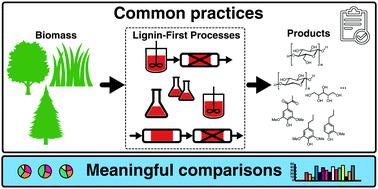当前位置:
X-MOL 学术
›
Energy Environ. Sci.
›
论文详情
Our official English website, www.x-mol.net, welcomes your feedback! (Note: you will need to create a separate account there.)
Guidelines for performing lignin-first biorefining
Energy & Environmental Science ( IF 32.5 ) Pub Date : 2020-10-15 , DOI: 10.1039/d0ee02870c Mahdi M. Abu-Omar 1, 2, 3, 4 , Katalin Barta 5, 6, 7, 8 , Gregg T. Beckham 4, 9, 10, 11, 12 , Jeremy S. Luterbacher 13, 14, 15, 16, 17 , John Ralph 4, 18, 19, 20 , Roberto Rinaldi 21, 22, 23, 24 , Yuriy Román-Leshkov 4, 21, 25, 26 , Joseph S. M. Samec 27, 28, 29, 30 , Bert F. Sels 31, 32, 33, 34 , Feng Wang 35, 36, 37, 38, 39
Energy & Environmental Science ( IF 32.5 ) Pub Date : 2020-10-15 , DOI: 10.1039/d0ee02870c Mahdi M. Abu-Omar 1, 2, 3, 4 , Katalin Barta 5, 6, 7, 8 , Gregg T. Beckham 4, 9, 10, 11, 12 , Jeremy S. Luterbacher 13, 14, 15, 16, 17 , John Ralph 4, 18, 19, 20 , Roberto Rinaldi 21, 22, 23, 24 , Yuriy Román-Leshkov 4, 21, 25, 26 , Joseph S. M. Samec 27, 28, 29, 30 , Bert F. Sels 31, 32, 33, 34 , Feng Wang 35, 36, 37, 38, 39
Affiliation

|
The valorisation of the plant biopolymer lignin is now recognised as essential to enabling the economic viability of the lignocellulosic biorefining industry. In this context, the “lignin-first” biorefining approach, in which lignin valorisation is considered in the design phase, has demonstrated the fullest utilisation of lignocellulose. We define lignin-first methods as active stabilisation approaches that solubilise lignin from native lignocellulosic biomass while avoiding condensation reactions that lead to more recalcitrant lignin polymers. This active stabilisation can be accomplished by solvolysis and catalytic conversion of reactive intermediates to stable products or by protection-group chemistry of lignin oligomers or reactive monomers. Across the growing body of literature in this field, there are disparate approaches to report and analyse the results from lignin-first approaches, thus making quantitative comparisons between studies challenging. To that end, we present herein a set of guidelines for analysing critical data from lignin-first approaches, including feedstock analysis and process parameters, with the ambition of uniting the lignin-first research community around a common set of reportable metrics. These guidelines comprise standards and best practices or minimum requirements for feedstock analysis, stressing reporting of the fractionation efficiency, product yields, solvent mass balances, catalyst efficiency, and the requirements for additional reagents such as reducing, oxidising, or capping agents. Our goal is to establish best practices for the research community at large primarily to enable direct comparisons between studies from different laboratories. The use of these guidelines will be helpful for the newcomers to this field and pivotal for further progress in this exciting research area.
中文翻译:

进行木质素优先生物精制的指南
现在已经认识到植物生物聚合物木质素的增价对于使木质纤维素生物精炼工业具有经济可行性至关重要。在这种情况下,“木质素优先”生物精炼方法(在设计阶段就考虑了木质素的平衡化处理)已证明了木质纤维素的最充分利用。我们将木质素优先方法定义为主动稳定化方法,该方法可从天然木质纤维素生物质中溶解木质素,同时避免导致更多难降解木质素聚合物的缩合反应。该活性稳定可以通过将反应性中间体溶剂化和催化转化为稳定产物或通过木质素低聚物或反应性单体的保护基化学来实现。在这个领域越来越多的文学作品中,有多种方法来报告和分析木质素优先方法的结果,从而使研究之间的定量比较具有挑战性。为此,我们在此提出了一套用于分析来自木质素优先方法的关键数据(包括原料分析和工艺参数)的准则,旨在将木质素优先研究界围绕一套共同的可报告指标进行联合。这些准则包括原料分析的标准和最佳实践或最低要求,强调分馏效率,产品收率,溶剂质量平衡,催化剂效率的报告,以及对其他试剂(如还原剂,氧化剂或封端剂)的要求。我们的目标是为整个研究界建立最佳实践,主要是为了使不同实验室的研究之间能够进行直接比较。这些指南的使用将对这一领域的新手有所帮助,并为在这个令人振奋的研究领域取得进一步进展起到关键作用。
更新日期:2020-12-17
中文翻译:

进行木质素优先生物精制的指南
现在已经认识到植物生物聚合物木质素的增价对于使木质纤维素生物精炼工业具有经济可行性至关重要。在这种情况下,“木质素优先”生物精炼方法(在设计阶段就考虑了木质素的平衡化处理)已证明了木质纤维素的最充分利用。我们将木质素优先方法定义为主动稳定化方法,该方法可从天然木质纤维素生物质中溶解木质素,同时避免导致更多难降解木质素聚合物的缩合反应。该活性稳定可以通过将反应性中间体溶剂化和催化转化为稳定产物或通过木质素低聚物或反应性单体的保护基化学来实现。在这个领域越来越多的文学作品中,有多种方法来报告和分析木质素优先方法的结果,从而使研究之间的定量比较具有挑战性。为此,我们在此提出了一套用于分析来自木质素优先方法的关键数据(包括原料分析和工艺参数)的准则,旨在将木质素优先研究界围绕一套共同的可报告指标进行联合。这些准则包括原料分析的标准和最佳实践或最低要求,强调分馏效率,产品收率,溶剂质量平衡,催化剂效率的报告,以及对其他试剂(如还原剂,氧化剂或封端剂)的要求。我们的目标是为整个研究界建立最佳实践,主要是为了使不同实验室的研究之间能够进行直接比较。这些指南的使用将对这一领域的新手有所帮助,并为在这个令人振奋的研究领域取得进一步进展起到关键作用。



























 京公网安备 11010802027423号
京公网安备 11010802027423号